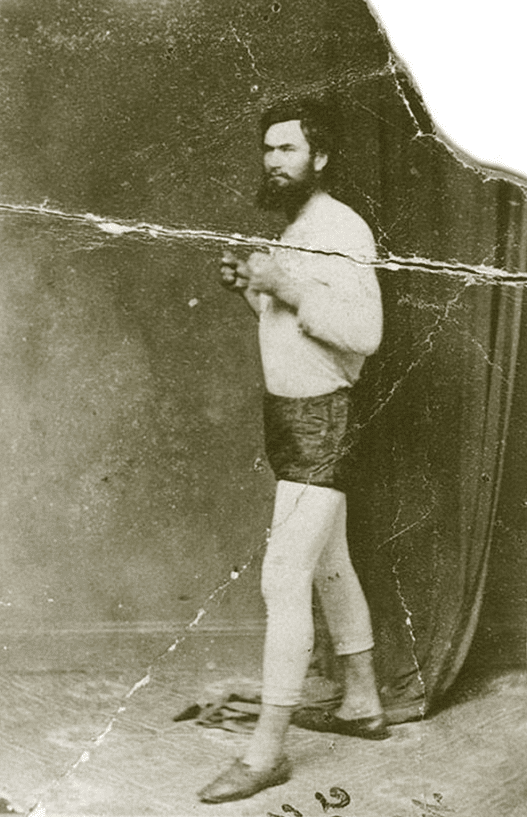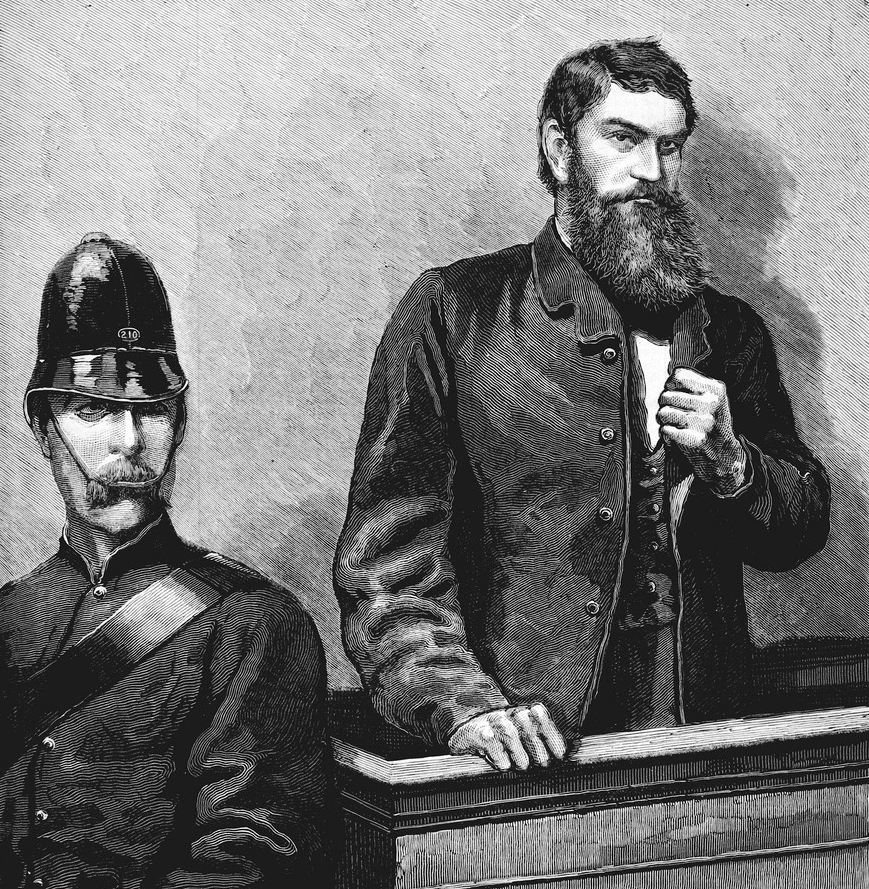If there’s one thing Australians are famous for, it’s our criminals – which probably shouldn’t be surprising. But when it comes to our criminals we’ve got a couple that are more famous than anyone else, and none are more famous than our bushrangers Ned Kelly and his Kelly gang. These Australian outlaws have become Australian icons, simultaneously considered an Australian hero and a criminal blot on Australian history. His armour is a tourist attraction, his place of death a heritage location, and his history a legend as vibrant as that of the English Robin Hood or the American Billy the Kid. But can we break through the myth and hype to uncover who he was?
Ned Kelly
A December baby born in 1854, Ned Kelly grew up the son of Irish expatriate Red Kelly in a climate that was extremely hostile to Irish citizens and Christian Catholics. The Irish Rebellion of 1803 followed by the Tithe War of the 1830s were the environment in which Red Kelly was raised, and many of the racisms of Britain were imported to Australia. For Ned, he grew up in a world that considered him inferior. Protestant sermons condemned the Irish as improvident drunkards and gamblers, and Protestant lawmakers ensured that the Irish did not hold any public or government office – a stance that would not change until 1901.
In 1864 the family moved from Beveridge to Avenel to escape public scrutiny. Red’s brother Jim, and members of his wife’s extended family had been accused of criminal activity, and Jim was convicted of cattle stealing. Thinking that they would be branded criminals, the family sold up and moved, but then Red himself was accused of cattle stealing. For the months in which his father was in prison, Ned became the father of the house, and in 1866 when his father died, he continued that role, until his own brush with the law in 1869.
Ned Kelly and The Law

After meeting the Irish born convict Henry Johnson (also known as Harry Power), The Kelly family became sympathisers and supporters of Henry’s criminal bush-ranging. Although he joined in with an attempted robbery, Kelly’s first brush with the law was in defence of his sister from a Chinese man named Ah Fook. Fook accused Ned of attacking him with a long stick and robbing him of 10 shillings, while Ned claimed that Fook had abused his sister Annie then had attacked Ned with a long stick. The charge was dismissed, but it began the trail of both Kelly’s bush ranging and police pursuit that would be the hallmarks of Ned’s life from that time forth.
In 1870 Ned and Henry committed a series of armed robberies of which Ned was accused of committing but a lack of evidence resulted in charges dropped and his release. Over the following years he was accused of horse theft, assault, and became the unofficial bare-knuckle boxing champion of Beechworth. His mother remarried. He would be arrested in 1877 for riding over a footpath while drunk, and the next day would be embroiled in a brawl with four police officers on the way to court. He would be charged with the crimes of being drunk and disorderly, resisting arrest and assaulting a police officer. However this brawl would lead to one of the assaulted officers, Alex Fitzpatrick, continually harassing the Kelly family. A month later Kelly and his step-father stole eleven horses from a nearby paddock, and in response to the police investigation that followed his step-father disappeared never to be seen again.
Ned Kelly and his Gang of Outlaws

This last robbery would prove to be Ned’s overall undoing. Alex Fitzpatrick took a warrant of arrest to Ned’s home, intending to arrest him for stealing the eleven horses in 1877. A scuffle ensued in which Alex was wounded by gunshot, and although stories differ, all of them end with Ned Kelly seizing officer Fitzpatrick’s firearm. An accusation of attempted murder was levied against Ned and his friends, and Williamson, Skillion and Ellen Kelly were charged with aiding and abetting attempted murder and subsequently arrested. Skillion and Williamson both received sentences of six years hard labour, and Ellen, who at the time was nursing a newborn, was sentenced with three years hard labour. Contemporaries at the time considered this to have been a very severe sentence compared to the charges that had been levied against them.
After this, Ned and Dan became outlaws, and the Kelly gang emerged out of their friends and sympathisers. During this time they were involved in multiple shootouts with police, received a bounty of £800 for their arrest (later £8000, the highest in bushranging history), a bank robbery known as the Eurora raid, and for a time they even took over the Jerilderie police station before robbing the Jerilderie bank. Then in 1880 came the fatefall final standoff in Glenrowan. The gang had decided to murder a contingent of police officers and Aaron Sheritt, a police informer about the actions of the Kelly gang, and a neighbour of Joe Byrne, one of the first members of the Kelly gang alongside Ned and Dan. After taking over the railway station, the gang used the Ann Jones Inn and the station master’s home to gather hostages. Intending to await a train to arrive with their target, they gathered 62 hostages – including plants to help contain the situation – but the train did not arrive on time. Just when the Kellys had decided to release their hostages, the train load of police officers arrived. Several hostages were injured or killed during the conflict, and the firefight continued into the night and into the following day. By afternoon, the officer in charge decided to burn the gang out of the inn, killing Dan and Hart in the blaze. Byrne had been killed earlier in the firefight, and Ned Kelly himself was arrested. Ned was put on trial, and despite a petition for clemency with over 32,000 signatures, he was soon convicted of murdering a police officer, and executed.
Most of this history is contentious, if only because multiple differing narratives of the events exist with some vilifying Ned and others vilifying the police, in particular the actions of Alex Fitzpatrick and the overzealous court, however despite the differing versions of events many of the key points remain intact. Of course, there remains a little bit of legend. Dan Kelly and Steve Hart were burned beyond recognition in the fire that levelled Anne Jones’s inn, which naturally opened up theories that the bodies found belonged to other people and that they somehow survived and escaped. The most popular story claims that they both wound up in South Africa and fought in the First Boer War.
Becoming an Australian Icon
Even before his death books, pamphlets and articles in both newspapers and magazines glorified him as an Australian hero. Many of the earliest printings portrayed him as a hero who robbed the rich and gave to the poor, while others condemned him as a criminal rampaging around Victoria preying on both banks and travellers. Almost from the outset Ned Kelly became embedded in Australian memory as a divisive yet near mythic figure. In 1906, only 26 years after his death, he became the central character in the first ever sixty minute movie, titled “The Story of the Kelly Gang”, and then became the central character in three more movies over the next 20 years, alongside many more over the subsequent decades. Most recently in the early 2000s, Peter Carey’s book, True History of the Kelly Gang, a fictional story detailing the life of Ned Kelly, won the Booker Prize and Heath Ledger starred in the 2003 dramatic retelling entitled Ned Kelly.
However, despite all the glorification there was pushback. Between 1880 and 1960, the government – in particular Victoria police – treated the Ned Kelly story with contempt. This only changed in the 1960s after matters of Australian independence and a need for a national identity outside of British cultures came to the forefront and Ned Kelly became the perfect example of Australian rebellious culture.
Where to go to experience Ned Kelly today
Possibly the first place to visit would be Glenrowan, which has a dedicated tourist centre to the Kelly gang alongside a number of fibreglass figurines depicting the final showdown between the police and the Kelly Gang. Another is Stringybark where tourists can visit the Kelly Tree, Beechworth, which has been maintained as a historic town, and Beveridge where what remains of Ned’s boyhood home can still be found. Another popular location that feeds into the Ned Kelly legend is the museum in Benalla where a long green sash was awarded to Ned for saving a young boy from drowning – a sash which he wore during his final battle at Glenrowan. However perhaps the most accessible and notable stop on a Ned Kelly tour would be the Old Melbourne Gaol, complete with Ned’s cell, the trapdoor where he was hung, and an original suit of armour worn by one of the gang. All of these can be found on the Ned Kelly Trail.







